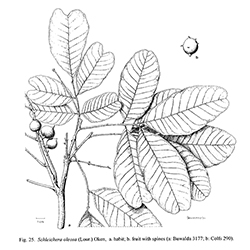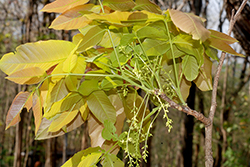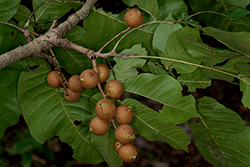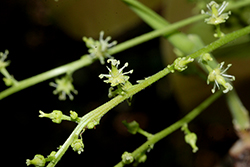e-Flora of Thailand
Volume 7 > Part 1 > Year 1999 > Page 241 > Sapindaceae > Schleichera
Schleichera oleosa (Lour.) Okenwfo-0001134603
Allg, Naturgesch. Bot. 2: 1341. 1841; Leenh. in Fl. Males., Ser. 1, Spermat. 11: 728, fig. 76. 1994 (see also for complete synonymy).— Pistachia oleosa Lour., Fl. Cochinch.: 615. 1790. Fig. 25.
Accepted Name : This is currently accepted.
Synonyms & Citations :
Description : Trees up to 40 m high; bark brown to grey to blackish, cracked and slightly flaking. Leaves 2–4-jugate. Leaflets elliptic to obovate, 4.5–18.5(–25) by 2.5–9 cm, lower ones much smaller, chartaceous to coriaceous; base oblique to rounded; apex emarginate to obtuse (to shortly acuminate); (sub)glabrous above, (sub)hirsute underneath, glabrescent. Inflorescences up to 15 cm long. Flowers pale yellow or pale green, fragrant. Sepals ovate to deltoid, ca 1.5 mm high. Stamens: filaments up to 2 mm long, pale yellow-green; anthers 0.75–1 mm long, yellowish. Fruits yellow, broad ovoid to subglobular, ca 15 by 13 mm when 1-seeded, 17–20 by ca 18 by 14 mm when 2-seeded, not lobed. Seeds dull medium-brown, ca 12 by 10 by 8 mm; arillode yellow, juicy, acidic.
Thailand : NORTHERN: Mae Hong Son, Chiang Mai, Lampang, Phrae, Tak, Sukhothai, Phitsanulok; NORTH-EASTERN: Phetchabun, Loei; EASTERN: Chaiyaphum, Nakhon Ratchasima, Surin, Si Sa Ket; SOUTH-WESTERN: Kanchanaburi, Ratchaburi; CENTRAL: Saraburi; SOUTH-EASTERN: Prachin Buri, Chon Buri, Chanthaburi.
Distribution : The original distribution probably unknown due to introductions and cultivation, presently disjunct, in the west from Sri Lanka and India (western Deccan) to Indochina and Thailand. In the east in parts of Indonesia (Java, Lesser Sunda Islands, Central Sulawesi, Moluccas, from latter presumably type).
Ecology : In regions with a dry period such as deciduous dipterocarp forests, mixed deciduous forests, savannas, on dry to periodically rather swampy soils of various types, sea level up to 900(–1,200) m alt. Flowering: January–April (to July); fruiting: March–July. The plants are fire resistant, deciduous, but leafless for only a few days. The seedlings are light-demanding. The seeds are eaten by mammals (probably mainly Viverridae) and birds, perhaps also dispersal by termites.
Vernacular : Kho (ค้อ, เคาะ), ta khro (ตะคร้อ); chok (โจ๊ก), kho som (คอส้ม), kho chok (เคาะโจ๊ก), ma chok (มะโจ๊ก), ma kho (มะเคาะ), mai ta khro (ไม้ตะคร้อ), mai kho (ไม้เคาะ)(Northern, Northeastern); sa-u-sek (ซะอู่เส่ก)(Karen-Mae Hong Son); ka-so (กาซ้อ), ka-song (กาซ้อง), khui (คุ้ย)(Karen-Kanchanaburi); pan-rong (ปันโรง)(Khmer-Buri Ram); pan-rua (ปันรัว)(Khmer-Surin); ta khro khai (ตะคร้อไข่)(Southwestern).
Uses: The wood is used for timber and makes an excellent charcoal. The bark is used for dyeing and as a native medicine. Young leaves may be eaten as a vegetable and the arillode as a titbit. Oil can be pressed from the seeds; one of its purposes is a medicinal use much as a substitute for the true Makassar oil.
Notes: This species loses its leaves during the dry period and produces a new flush when it starts to flower. The leaves of the flowering specimens are strikingly different (soft, often very pilose, small) from the ones of specimens with mature fruits (stiff, glabrous, large to very large).




